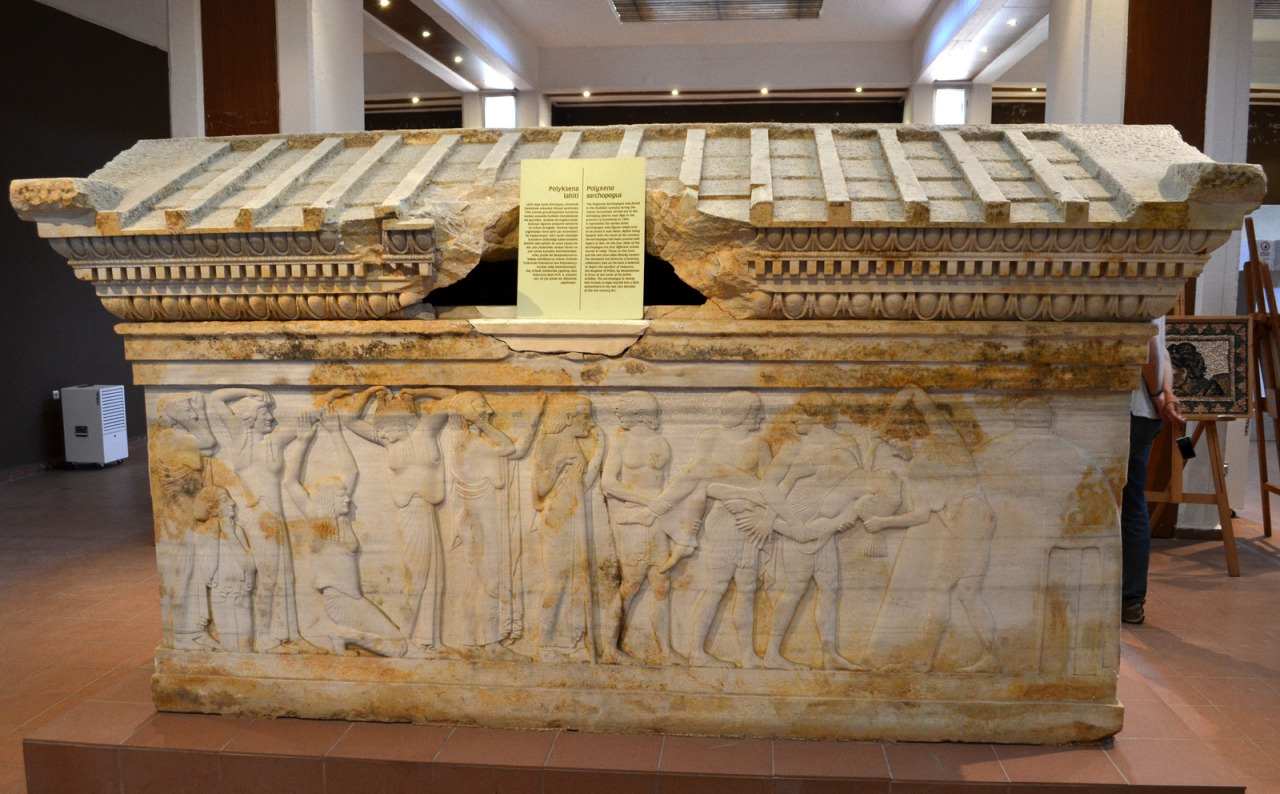Polyxena’s Sarcophagus: Myth and Burial Intertwined
Then, back in 1994, this incredible tomb was found in Türkiye, and it’s like a time capsule from 2,500 years ago! It shows this really intense moment from Greek mythology where Princess Polyxena is sacrificed to the ghost of Achilles after the Trojan War. Now you can see it at the Istanbul Archaeological Museums, where they have done a great job keeping this dramatic story alive.
In 1994, archaeologists made an extraordinary find in the Granicus River valley near Biga, in the Turkish province of Çanakkale, which illuminated aspects of both ancient funerary practices and Greek mythology. Unearthed as part of a rescue excavation following reports of illegal excavations, this site revealed two notable marble sarcophagi within a tumulus or burial mound. This discovery, known today as the Sarcophagus of Polyxena, continues to offer historians a rich insight into the interaction of art, myth and society in ancient Anatolia.

Polyxena’s sacrifice scene
The centerpiece of the find was a sarcophagus dating from approximately 500 to 490 BC. C., adorned with intricate carvings representing the mythological sacrifice of Polyxena, the Trojan princess. According to Greek legend, Polyxena was the youngest daughter of King Priam and Queen Hecuba of Troy. After the fall of Troy, the Greeks, led by Neoptolemus (son of Achilles), demanded that she be sacrificed in Achilles’ tomb as a tribute to the fallen hero. The Greeks believed this would appease their spirit and allow them to travel safely home.

The Polyxena Sarcophagus uniquely portrays this moment with an emotional and artistic intensity rarely seen in contemporary works. In the scene, Polyxena is shown in a moment of vulnerability, surrounded by Greek warriors and priests, with Neoptolemus prepared to carry out the ritual. The figures are represented with great attention to detail, from the expressions of the mourners to the elegance of Polixena’s clothing. This depiction captures the raw emotional weight of the scene while illustrating a tragic aspect of Trojan culture and the influence of Greek myth on Anatolian funerary art.

The second sarcophagus: a mysterious burial
Next to Polyxena’s sarcophagus was another simpler marble sarcophagus containing the remains of a 10-year-old girl. This tomb, dated between 40 and 50 years later, raises many questions for archaeologists. The girl’s identity remains unknown, but the style and location of her burial suggest that she may have been part of an elite family, possibly of Anatolian origin with Greek cultural influences.

The proximity of this burial to Polyxena’s sarcophagus hints at a continued reverence for the site and perhaps even for the mythological history it portrays. Some scholars suggest that the girl’s burial near Polyxena’s tomb may have been intended to honor the deceased or align her memory with Polyxena’s legendary sacrifice, although the exact reason remains speculative. The combination of these burials shows the combination of local customs with Greek mythological themes, emphasizing the cultural exchange between Anatolia and the Greek world.

Importance of the Polyxena sarcophagus in archeology and art
The sarcophagus of Polyxena has become a crucial artifact for understanding the interaction between Greek and Anatolian cultures during the Archaic period. In Greek culture, sarcophagi decorated with mythological scenes were common, but finding such elaborate works of art in Anatolia suggests that Greek myths and artistic techniques were well known and perhaps even revered in this region.

Additionally, the Polyxena sarcophagus scene offers insights into how myths served both religious and social functions. Polyxena’s sacrifice symbolized themes of loyalty, honor, and tragedy, all of which resonated with audiences across cultural boundaries. By representing the story of Polixena, the sarcophagus also became a vessel of cultural identity, reflecting values important to the local elite.
A look at archaic funeral customs
The use of intricately decorated burial mounds and sarcophagi sheds light on the funerary customs of the time. Burials within mounds were typically reserved for the elite, making the site a prestigious resting place. This type of burial was an honor, indicated high status or lineage, and hinted at the possible influence of Greek funerary practices on Anatolian rituals. The inclusion of mythological scenes may have served not only to honor the deceased but also to reinforce the family’s social status and alignment with revered cultural narratives.
Polyxena’s sarcophagus remains a remarkable artifact that unites the worlds of myth, art and archaeology. Its discovery and preservation have enriched our understanding of the cultural connections between ancient Greece and Anatolia, offering a tangible link to the beliefs, artistic expressions and social values of the time. As archaeologists continue to study this site, the Polyxena Sarcophagus will undoubtedly continue to inspire new interpretations and knowledge, providing a lasting legacy of a lost world where myth and reality intersected in the most tangible way.






